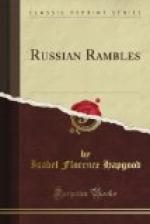Shortly after, the question fever having attacked me again, I accosted another monk, equal in stateliness of aspect to the Father Treasurer. He informed me that from seven hundred to one thousand persons lived in the monastery. Not all of them were monks, some being only lay brethren. Each monk, however, had his own apartments, with a little garden attached, and the beautiful rugs which I had seen formed part of the furnishings of their cells. A man cannot enter the monastery without money, but fifty rubles (about twenty-five dollars) are sufficient to gain him admittance. Some men leave the monastery after a brief trial, without receiving the habit. “In such a throng one comes to know many faces,” he said, “but not all persons.”
I inquired whether it were not a monotonous, tiresome life.
“It seems so to you!” he replied, when he had recovered from his amazement; and when I mentioned the liturgy which is peculiar to the monastery cathedral, and famed throughout Russia as “the Kieff-Catacombs singing,” all he found to say was, “It is very long.”
He took advantage of the chance presented by a trip to his cell to get us some water, to remove his tall klobuk. He must have read in our glances admiration of his beauty mingled with a doubt as to whether it were not partly due to this becoming cowl and veil, and determined to convince us that it was nature, not adventitious circumstances, in his case. I think he must have been content with the expression of our faces, as he showed us the way to the most ancient of all the churches in Kieff,—in Russia, in fact,—built by Prince-Saint Vladimir immediately after his return from the crusade in search of baptism.
The church door was locked. The wife of the deacon in charge was paddling about barefooted, in pursuit of her fowls, in the long grass of the dooryard. She abandoned the chickens and hunted up her husband, who took a peep at us, and then kept us waiting while he donned his best cassock before escorting us.
It is a very small, very plain church which adjoined Prince Vladimir’s summer palace, long since destroyed, and still preserves its gallery for women and servants, and a box for the ladies of the household. Everything about it is nine hundred years old, except the roof and the upper portion of the walls. The archaic frescoes of angels in the chancel, which date from the same period, and are the best in Kieff, were the only objects which the deacon could find to expound, to enhance the “tea-money” value of his services in putting on his best gown and unlocking the door, and he performed his duty meekly, but firmly. We did ours by him, and betook ourselves to the principal church, the Cathedral of the Assumption, where less is left to the imagination.
There, very few of the frescoes are more than a hundred and sixty years old, the majority dating back less than sixty years, and being in a style to suit the rococo gilt carving, and the silver-gilt Imperial Gate to the altar. In the papert, or corridor-vestibule, a monk who was presiding over a Book of Eternal Remembrance invited us to enter our subscriptions for general prayers to be said on our behalf, or for special prayers to be said before the “wonder-working image” of the Assumption so long as the monastery shall exist.




